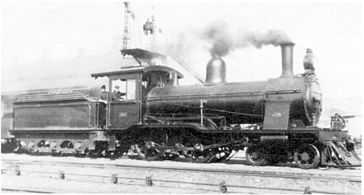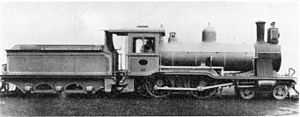CGR 3rd Class 4-4-0 1901
| CGR 3rd Class 4-4-0 1901 to South African Class 03 4-4-0 1901 | |
|---|---|
|
CGR 3rd Class 4-4-0 of 1901 Wynberg Tender | |
| Type and origin | |
| Power type | Steam |
| Designer | Cape Government Railways |
| Builder | Sharp, Stewart and Company |
| Serial number | 4710-4715 |
| Build date | 1901 |
| Total produced | 6 |
| Specifications | |
| Configuration | 4-4-0 "American" |
| Gauge | 3 ft 6 in (1,067 mm) Cape gauge |
| Leading wheel diameter | 28 1⁄2 in (724 mm) |
| Driver diameter | 60 in (1,520 mm) |
| Wheelbase |
7 ft (2.134 m) coupled 5 ft 3 in (1.600 m) bogie 19 ft 6 1⁄8 in (5.947 m) engine 10 ft (3.048 m) tender 40 ft 7 3⁄4 in (12.389 m) total |
| Length | 49 ft 9 in (15.164 m) over couplers |
| Height | 12 ft 10 in (3.912 m) |
| Axle load | 14 long tons (14.2 t) per driver |
| Weight on drivers | 28 long tons (28.4 t) |
| Locomotive weight | 40 long tons (40.6 t) w/o |
| Tender weight | 30 long tons (30.5 t) w/o |
| Locomotive and tender combined weight | 70 long tons (71.1 t) w/o |
| Tender type | Three-axle, 37 in (940 mm) wheels |
| Fuel type | Coal |
| Fuel capacity | 5 long tons (5.1 t) |
| Water capacity | 2,350 imp gal (10,700 l; 2,820 US gal) |
| Boiler |
4 ft 2 5⁄8 in (1.286 m) inside diameter 10 ft 0 3⁄8 in (3.058 m) length inside 6 ft 9 in (2.057 m) pitch |
| Boiler pressure | 165 psi (1,140 kPa) |
| Firegrate area | 16.8 sq ft (1.561 m2) |
| Heating surface: – Tubes | 850 sq ft (78.968 m2) |
| – Firebox | 92 sq ft (8.5 m2) |
| – Total | 942 sq ft (87.5 m2) |
| Cylinders | Two |
| Cylinder size |
17 in (432 mm) bore 24 in (610 mm) stroke |
| Valve gear | Stephenson |
| Performance figures | |
| Tractive effort | 14,310 lbf (64 kN) at 75% pressure |
| Career | |
| Operator(s) |
Cape Government Railways South African Railways |
| Class | CGR 3rd Class, SAR Class 03 |
| Number in class | 6 |
| Number(s) | 6-11 |
| Delivered | 1901 |
| First run | 1901 [1][2] |
| Withdrawn | c. 1932 |
| Disposition | All scrapped |
The CGR 3rd Class 4-4-0 of 1901 is a South African steam locomotive from the pre-Union era in the Cape Colony.
In 1901 the Cape Government Railways placed another six 3rd Class Wynberg Tender locomotives with a 4-4-0 American type wheel arrangement in suburban service in Cape Town. They were a heavier and more powerful version of the locomotives of 1898.[1][2]
Manufacturer
Six more 3rd Class Wynberg Tender passenger locomotives entered service on the Cape Government Railways (CGR) in 1901 for suburban service in Cape Town. They were built by Sharp, Stewart and Company and numbered in the range from 6 to 11.[1][2]
These locomotives were very similar in design to the first six of 1898, but larger and more powerful. They were built for speed and had the largest coupled wheels of any locomotive on the CGR to date, at 60 inches (1,520 millimetres) diameter. In later years this driving wheel size became the accepted size for mixed traffic and general purpose locomotives on mainline service in South Africa. During the rest of the steam era in South Africa only four locomotive types were to be introduced with larger driving wheels, post-delivery modifications excluded.[1]
Service
Cape Government Railways
These locomotives were also known as Wynberg Tenders. They were also delivered with reverse running in mind, with a weatherboard mounted on the tender front to protect the crew from the elements when running tender first. These weatherboards were later removed, possibly when a turntable was constructed at the Simon's Town terminal.[1]
South African Railways

The Union of South Africa was established on 31 May 1910, in terms of the South Africa Act. One of the clauses in the Act required that the three Colonial Government railways, the CGR, the Natal Government Railways and the Central South African Railways, also be united under one single administration to control and administer the railways, ports and harbours of the Union. While the South African Railways (SAR) came into existence in 1910, the actual classification and renumbering of all the rolling stock of the three constituent railways required careful planning and was only implemented with effect from 1 January 1912.[3][4]
In 1912 the six locomotives were considered obsolete by the SAR, designated Class 03 and renumbered by having the numeral 0 prefixed to their existing numbers. In SAR service they continued to work suburban trains. Despite being considered obsolete, all six survived until c. 1918, when two were withdrawn from service. The other four survived in service until after 1931.[2][4]
Works numbers
The works numbers, original numbers and renumbering of the Cape 3rd Class of 1901 are shown in the table.[1][4]
Works no. |
Orig. no. |
SAR no. |
|---|---|---|
| 4710 | 6 | 06 |
| 4711 | 7 | 07 |
| 4712 | 8 | 08 |
| 4713 | 9 | 09 |
| 4714 | 10 | 010 |
| 4715 | 11 | 011 |
See also
- CGR 3rd Class 4-4-0 1883
- CGR 3rd Class 4-4-0 1884
- CGR 3rd Class 4-4-0 1889
- CGR 3rd Class 4-4-0 1898
- CGR 3rd Class 4-4-0 1903
- List of South African locomotive classes
- South African locomotive history
- The 4-4-0 "American"
References
|
- ↑ 1.0 1.1 1.2 1.3 1.4 1.5 Holland, D.F. (1971). Steam Locomotives of the South African Railways, Volume 1: 1859-1910 (1st ed.). Newton Abbott, Devon: David & Charles. pp. 59–60. ISBN 978-0-7153-5382-0.
- ↑ 2.0 2.1 2.2 2.3 Paxton, Leith; Bourne, David (1985). Locomotives of the South African Railways (1st ed.). Cape Town: Struik. p. 18. ISBN 0869772112.
- ↑ The South African Railways - Historical Survey. Editor George Hart, Publisher Bill Hart, Sponsored by Dorbyl Ltd., Published c. 1978, p. 25.
- ↑ 4.0 4.1 4.2 Classification of S.A.R. Engines with Renumbering Lists, issued by the Chief Mechanical Engineer’s Office, Pretoria, January 1912, p. 26. (Reprinted in April 1987 by SATS Museum, R.3125-6/9/11-1000)
